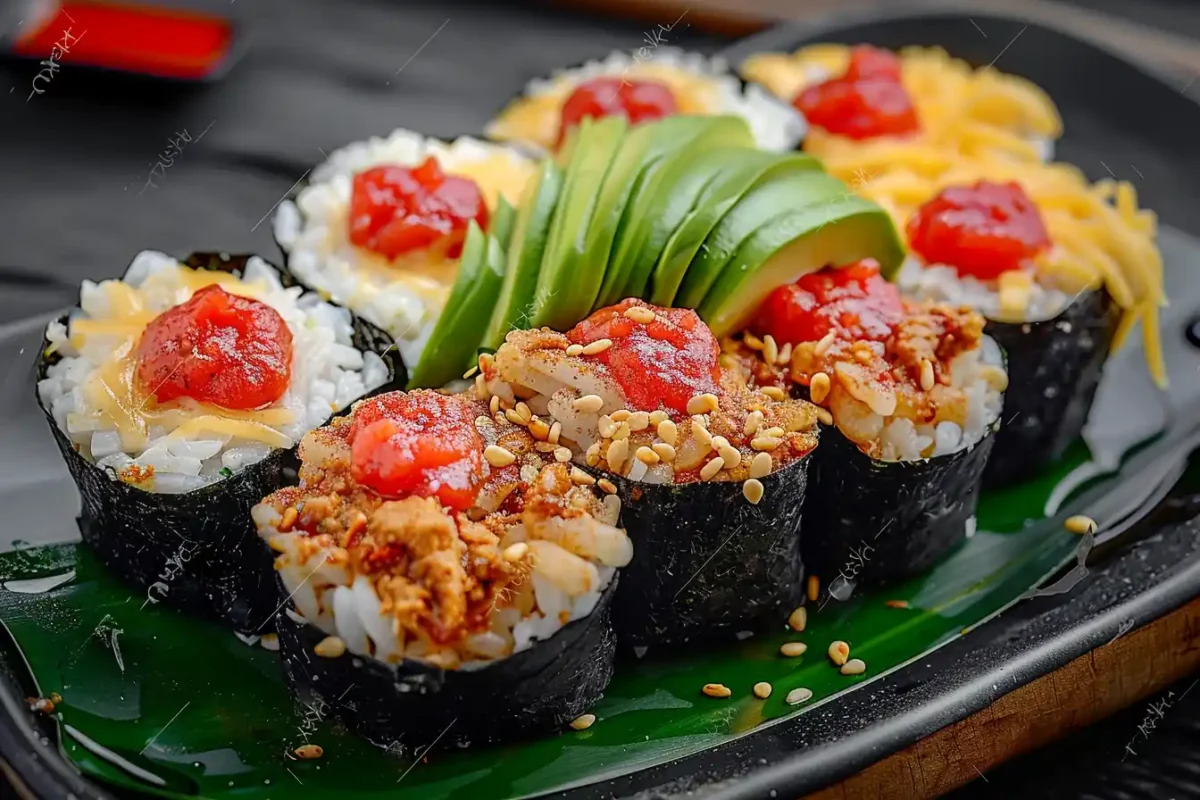Tobiko, the vibrant and crunchy fish roe, offers a unique culinary experience. It is often used in Japanese cuisine. This article explores its origins, taste, and various uses. Learn all about this fascinating ingredient.
What is Tobiko?
Tobiko refers to the flying fish roe. These tiny eggs add both flavor and texture to many dishes. They are notably used in sushi and other seafood-based preparations. This fish roe is small, round, and often comes in striking colors. Additionally, it provides a satisfying crunch when you eat it.
The Origins of This Unique Roe
The flying fish, responsible for creating this roe, is found in warm ocean waters. These fish lay their eggs in clumps on seaweed. Later, these eggs are harvested and processed. Consequently, the process involves washing, salting, and sometimes coloring the eggs. This careful handling preserves the roe and prepares it for cooking.
The Unique Taste of Flying Fish Roe
This roe has a mild, salty taste with a hint of sweetness. Moreover, it offers a satisfying pop when you bite into it. Many describe the taste as slightly briny with a subtle fishy note. This makes it an excellent ingredient. It enhances both the flavor and texture of various dishes. Its mild flavor means it can also pair with other ingredients without overpowering them.
The Nutritional Profile
Like other fish roe, this ingredient has some beneficial nutritional value. It is a source of protein and contains some vitamins and minerals. However, this roe is typically consumed in small quantities. Thus, it should be seen as a complement to, not a primary source of, these nutrients.
Important Protein Source in Fish Roe
This roe provides protein, which is crucial for building and repairing tissues. However, because of the small servings, it’s a small protein contributor. Accordingly, it should be part of a balanced protein intake.
A Few Vitamins and Minerals
This roe also contains some vitamins, including B12 and other B vitamins. Furthermore, it provides some trace minerals like selenium. However, the amounts are small in comparison to other foods. Therefore, rely on a diet of varied ingredients to get proper amounts of these components.
Considerations of Consumption
This ingredient is high in sodium. Also, it has a high cholesterol content. These factors may be of concern for some people. Therefore, this roe should be eaten in moderation. Especially those who are watching their sodium intake or cholesterol levels. Nonetheless, for most people, it can be a safe addition to a diverse diet.
Colors and Tobiko: Exploring the Variety
This fish roe is available in many colors, not just the natural orange. The colors are typically produced using natural coloring agents. Therefore, the color differences do not change the nutritional value much.
Natural Orange Flying Fish Roe
The natural color of this roe is orange. It comes from the roe itself. Therefore, the vibrant orange is a common sight in many sushi restaurants. Additionally, its natural color makes it a visually appealing food.
Other Colors of this Fish Roe
You can also find this roe in other colors such as green, red, and black. Green is typically made using wasabi flavoring. Red often uses beet juice, and black may utilize squid ink. Consequently, this variety in colors allows chefs to create interesting and unique presentations.
Tobiko Color Meaning and Its Impact
The color of this roe affects the presentation of food more than the taste. However, the different flavorings in colored versions can enhance the overall dish. Ultimately, the color is largely an aesthetic choice. It adds a visual appeal to dishes that use this roe.
Culinary Applications: A Versatile Ingredient
This roe is a versatile ingredient, widely used in many culinary applications. Its unique flavor and texture make it very desirable. It is particularly popular in Japanese cuisine. This ingredient also appears in fusion dishes as well.
Tobiko in Sushi Rolls: A Classic Pairing
This roe is a very common topping for sushi. It gives a great crunch and a pop of flavor. In addition, it can also be mixed into the sushi rice. Therefore, the eggs add another layer of both texture and visual appeal to the roll.
Tobiko on Appetizers: Enhancing Flavor and Presentation
This roe works well on appetizers, adding a flavor and texture boost. For example, you can add it on top of canapés, deviled eggs, or even small crackers. The colorful eggs enhance the appetizer’s presentation. Consequently, this makes your treats more appealing and delicious.
Other Ways to Use this Unique Fish Roe
This roe can also enhance salads, seafood dishes, and pasta. You can even use it as a garnish on soups and creamy sauces. Its versatility makes it a favorite ingredient. It will make every dish more interesting.
How to Store Tobiko Properly: Maintaining Freshness
Storing this roe correctly is essential to maintain its quality. The proper methods help keep it fresh. By doing this, you will ensure the best flavor and texture.
Refrigerating This Ingredient for Best Results
Always store this roe in the fridge. Once you open the container, you should keep it in an airtight container. Make sure to consume it within a few days. This method keeps the roe from drying out. It will also keep it safe to eat.
Freezing Tobiko for Longer Storage
You can also freeze this roe. This is useful for longer storage. Thaw it in the refrigerator before use to maintain its texture. However, freezing may affect its texture slightly. Despite this, it is a good way to preserve it.
Best Practices for Tobiko Storage: Ensuring Quality
Keep this roe away from strong odors to avoid it absorbing them. Also, avoid exposing it to air. Proper storage keeps the roe at its best. Thus, it will be an even better addition to your dishes.
Preparing Dishes With Tobiko: Simple Techniques
Working with this roe is generally simple. There are a few key things to remember when cooking with it. This ensures you get the best results when using it.
Using This Fish Roe as a Garnish: A Finishing Touch
This roe is a great garnish because of its color and texture. Just sprinkle it on your dishes right before serving. This way you preserve its crispness. It adds an attractive final touch to any dish.
Incorporating Tobiko in Mixtures: Preserving Texture
If you’re mixing this roe into a dish, add it last. This preserves the texture and flavor. Gentle mixing is best to keep the eggs intact. This keeps their texture so they are still fun to eat.
Combining Tobiko With Other Flavors: Ideal Culinary Pairings
This roe pairs well with many other flavors. It particularly compliments seafood, wasabi, and citrus. It is easy to match this roe with other things. Exploring various pairings can create exciting flavor combinations.
Frequently Asked Questions (FAQs)
Is tobiko real fish eggs?
Yes, tobiko is indeed real fish eggs. They are the roe of the flying fish. These eggs are harvested and then processed for consumption. Thus, the tobiko you eat comes directly from the fish.
What is tobiko?
Tobiko is the Japanese name for flying fish roe. It is very popular in Japanese cuisine. It is known for its crunchy texture, mild, salty taste. It is often used to garnish sushi, salads, and other dishes.
Are caviar and tobiko the same?
No, caviar and tobiko are not the same. Caviar is the roe of sturgeon. Tobiko, on the other hand, is the roe of the flying fish. Caviar is generally much more expensive than tobiko due to the rarity of the sturgeon. Additionally, the flavors and textures are also different.
What is tobiko vs masago?
Tobiko and masago are both fish roe. However, they come from different fish. Tobiko is the roe of the flying fish. Masago, however, is the roe of the capelin fish. Tobiko is larger, and it has a brighter color. It also has a more pronounced crunch. Masago is smaller, softer, and less expensive than tobiko.

